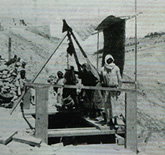|
|
|

Warren's Shaft System
This subterranean, rock-cut water-supply system enabled the inhabitants of the ancient city to draw the waters of the Gihon Spring in times of siege without leaving the walled area. The impressive system was discovered in 1867 by Sir Charles Warren, a military engineer sent by the British Palestine Exploration Fund to explore Jerusalem. The latest excavations (1997�1998) and discoveries by the Gihon Spring, dictated a review of the whole system; it now appears that the water-supply system was first constructed in the Middle Bronze Age II (eighteenth�seventeenth centuries BCE).
The Gihon Spring wells up in the riverbed of the Kidron Valley, at the foot of the steep east slope of the City of David spur, outside the city walls. This location deprived the settlers on the nearby hill of a regular supply of water in times of war and siege. Warren's Shaft Water-supply System was constructed to permit underground access from within the city, through a sloping tunnel, which reached the Gihon Spring. The tunnel was hewn in two directions: one team of laborers dug downward from the fortified area of the city; the other began at the bottom, in a natural cave on the slope of the City of David, above the Gihon Spring. Both teams took care to work only in the soft stratum of rock (melekeh formation). The upper team cut through the rock in a straight but sloping line, until they reached the top of a hard rock stratum (mizi ahmar formation); the other team cut a tunnel in a route that curved round to join the other team at the lower end of the upper tunnel. The meeting point of the two teams is indicated by a few discrepancies in the walls and rock ceiling, as well as by the different directions of the chiseling scars. |
Later, the sloping tunnel was deepened for some unknown reason. Visitors descending through the tunnel will note the change in the nature of the rock - the upper strata are softer. While deepening the tunnel the workers accidentally discovered a vertical fissure (dissolution chimney), the upper end of which they presumably widened. The shaft - now known as Warren's Shaft - descends about thirteen meters to the level of the Gihon Spring.
The earth and debris which had filled Warren's Shaft and some of the rock-cut tunnels leading to it were cleared in 1909�1911 by a British expedition headed by Montague Parker, a British adventurer who, inspired by a friend's dream, came to look for the treasures of Solomon's Temple. His work was documented by another scholar of Jerusalem's past, Louis Hugues Vincent, abbot of the Dominican Monastery of St. Etienne; Vincent's report was the basis for all subsequent research of this particular site. However, potsherds and other finds were cleared away together with the debris that filled the various parts of the system, resulting in the loss of important data that could have helped to date the whole system. Archaeologists attempting to date the system could therefore rely only on 'historical logic' and on comparisons with supposedly similar water-supply systems elsewhere.
The entrance to Warren's Shaft, blocked since the early twentieth century, was re-exposed in 1978 by an archaeological expedition headed by Yigal Shiloh. It was then generally agreed that in times of siege the townspeople could enter the sloping tunnel out of sight and reach the top of Warren's Shaft, from where they could lower buckets on ropes and draw small quantities of water from the Gihon Spring. |
|
Recent excavations (1997�1998), headed by Ronny Reich and Eli Shukrun, exposed remains of massive fortifications around and near the Gihon Spring (Site 29), which were dated to the Middle Bronze Age II (eighteenth�seventeenth centuries BCE). These remains called for a reexamination of the water-supply system. It is now understood that the sloping tunnel originally connected the city within the walls with the Gihon Spring itself and with a collection pool nearby, both of which were fortified. It is also now believed that at that time Warren's Shaft was not at all visible or known. The original construction of the sloping tunnel must therefore be dated to the same time as the Gihon Spring fortifications, that is, the Middle Bronze Age II. The deepening of the tunnel and the use of Warren's Shaft probably took place toward the late Iron Age, in the eighth century BCE. Interactive Map
|

|


